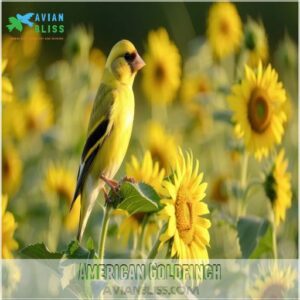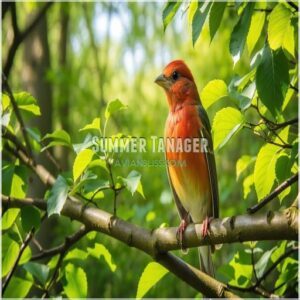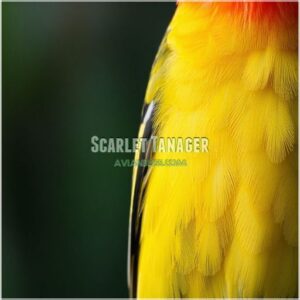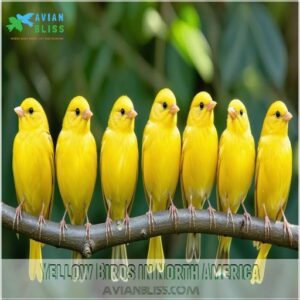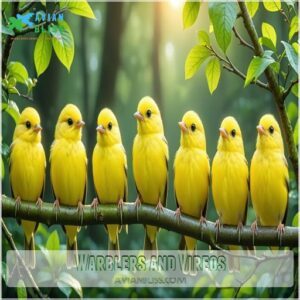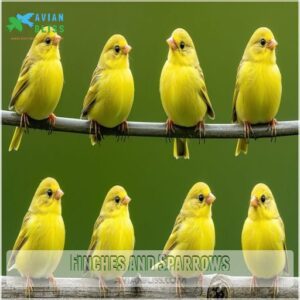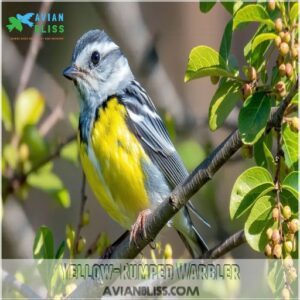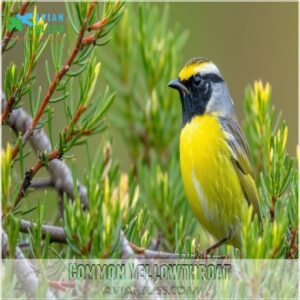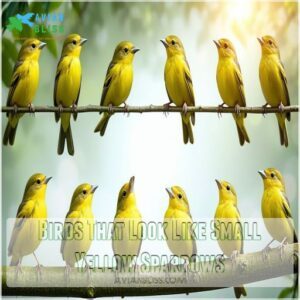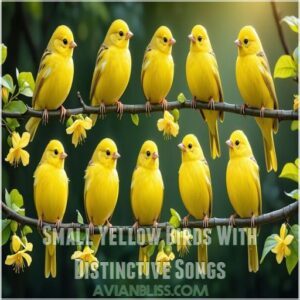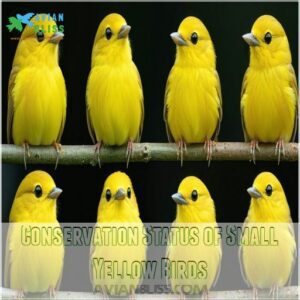This site is supported by our readers. We may earn a commission, at no cost to you, if you purchase through links.
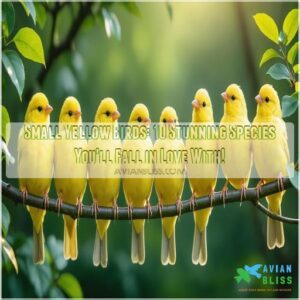 Small yellow birds bring joy wherever they flutter, adding a burst of color and melody to their surroundings.
Small yellow birds bring joy wherever they flutter, adding a burst of color and melody to their surroundings.
The American Goldfinch, a favorite at backyard feeders, flashes bright plumage and performs charming aerial acrobatics.
Yellow Warblers, on the other hand, light up woodland edges with their sunny feathers and melodious songs, while Prothonotary Warblers prefer hidden wetlands, nesting in tree cavities like tiny aviary architects.
Even female Summer Tanagers, though technically red birds, dazzle in yellow! Each species has a unique charm, making birdwatching exciting.
Keep an eye out—you never know which golden gem might visit your yard next!
Table Of Contents
- Key Takeaways
- Types of Small Yellow Birds
- Yellow Birds in North America
- Warblers and Vireos
- Finches and Sparrows
- Small Yellow Birds With Unique Features
- Birds That Look Like Small Yellow Sparrows
- Small Yellow Birds With Distinctive Songs
- Attracting Small Yellow Birds to Your Yard
- Identifying Small Yellow Birds
- Conservation Status of Small Yellow Birds
- Frequently Asked Questions (FAQs)
- What birds are yellow?
- Are there Yellow Birds in North America?
- Are there Yellow Birds in your backyard?
- What do yellow birds look like?
- What is a yellowthroat bird?
- Where can I find information about small yellow birds?
- What is a small yellow bird that looks like a finch?
- What do you call a little yellow bird?
- What is the most common yellow bird?
- What small bird looks like a goldfinch?
- Conclusion
Key Takeaways
- You’ll find small yellow birds like American Goldfinches, Yellow Warblers, and Prothonotary Warblers brightening forests, fields, and backyards with their vivid plumage and charming songs.
- Attract these birds to your yard by providing sunflower seeds, nectar-rich flowers, birdbaths, and native plants while avoiding harmful pesticides.
- Pay attention to plumage patterns, beak shape, songs, and behaviors to identify different yellow bird species with accuracy.
- Climate change, habitat loss, and food scarcity pose threats to yellow bird populations, but conservation efforts and bird-friendly practices can make a positive impact.
Types of Small Yellow Birds
Have you ever marveled at the vibrant small yellow birds flitting through your backyard or local park, catching sunlight with their brilliant plumage?
From the cheerful American Goldfinch to the striking Prothonotary Warbler, these tiny feathered friends will captivate your imagination with their stunning colors and remarkable behaviors.
American Goldfinch
These sunshine-yellow acrobats will steal your heart! American Goldfinches bring joy wherever they flutter.
- Seed-munching masters of backyard feeders
- Aerial dance champions
- Vibrant summer plumage performers
- Melodic chirping virtuosos
Yellow Warbler
Darting through woodland edges, the Yellow Warbler flashes brilliant yellow feathers, enchanting bird lovers with its melodious song and nimble flight.
| Feature | Description |
|---|---|
| Color | Bright yellow |
| Habitat | Woodland edges |
| Song | Melodious chirp |
These small yellow birds migrate incredible distances, bringing joy to nature enthusiasts everywhere.
Prothonotary Warbler
One dazzling Prothonotary Warbler lights up swampy woodlands with its vibrant yellow plumage, showcasing nature’s hidden gems.
- Master cavity nesters in wetland habitats
- Insectivore with a sweet, melodic song
- Key species for ecosystem conservation
- Rare beauty in southeastern US swamps
Summer Tanager
After exploring the Prothonotary Warbler’s bright plumage, you’ll love the Summer Tanager’s unique charm.
These yellow females and crimson males specialize in bee and wasp hunting, building high-rise nests in southern forests.
They’re nature’s aerial acrobats, stripping stingers before feasting on buzzing prey.
Scarlet Tanager
As the Summer Tanager takes a bow, the Scarlet Tanager steps into the spotlight, dazzling birdwatchers with its stunning yellow non-breeding plumage and intriguing transformation.
- Vibrant seasonal color shifts
- Unique migration strategies
- Unexpected plumage adaptations
Yellow Birds in North America
North America boasts an incredible diversity of small yellow birds.
These vibrant feathered friends will captivate your imagination and spark your curiosity.
From the bright American Goldfinch to the elusive Yellow Warbler, you’ll discover a stunning array of species that call this continent home, each with its unique personality and remarkable adaptations.
Common Yellow Birds in The US
If you’re scanning the skies, common yellow birds in the US will catch your eye faster than a flash of sunshine.
The American Goldfinch leads the parade, with its vivid breeding plumage drawing bird enthusiasts nationwide.
From backyard feeders to woodland edges, these small yellow birds showcase remarkable diversity, offering birdwatchers a glimpse into the vibrant world of regional avian life.
Yellow Birds in Canada
After spotting vibrant yellow birds across the US, you’ll love Canada’s feathered gems!
These winged wonders dance through northern landscapes:
- Canada Warblers paint waterside scenes
- Cape May Warblers traverse eastern skies
- Orange-Crowned Warblers whisper migration tales
- Warbling Vireos sing wilderness symphonies
Rare sightings await your keen eye!
Yellow Birds in Mexico
Want to spot three vibrant yellow birds dancing through Mexican skies?
Mexico hosts incredible migrating warblers like the Townsend’s and Black-throated Green Warbler, each painting landscapes with golden feathers.
Your bird identification guide reveals regional variations: forest dwellers, mountain specialists, and water-loving species.
Conservation challenges threaten these endemic treasures, making every sighting a precious moment in understanding migration patterns and protecting small yellow bird habitats.
Warblers and Vireos
Get ready to explore the vibrant world of warblers and vireos, two groups of small yellow birds.
You’ll discover eight incredible species that range from the cheerful Magnolia Warbler to the distinctive Yellow-Throated Vireo.
Each bringing its own unique splash of color and charm to North American forests and woodlands. They’ll capture your heart with their stunning plumage and energetic personalities.
Magnolia Warbler
You’ll spot the striking Magnolia Warbler’s black necklace and yellow plumage dancing through eastern forests during migration.
Some warblers, like the Virginia’s Warbler, have distinct rufous crown patches.
Nashville Warbler
Nashville Warblers are small yellow birds famous for migration, insect-based diets, and their distinct, sweet songs echoing through forests.
- Tiny, vibrant travelers—migrating annually from Canada to Central America.
- Prefers shrubs and forest edges for breeding behavior and food-hunting.
- Conservation status remains stable, thanks to habitat adaptability.
Palm Warbler
Bouncing with energy, the Palm Warbler darts through boreal forests, its yellow-olive plumage a beacon of wilderness and untamed spirit.
Attract these wild birds with a palm warbler birdhouse.
Hooded Warbler
After tracking down small yellow birds like the Palm Warbler, you’ll love the Hooded Warbler’s unique charm. This southeastern forest dweller sports a striking black hood and melodious song that’ll make any birder’s heart skip a beat.
- Find it hiding in dense forest underbrush
- Listen for its quick, cheerful melody
- Watch for its distinctive black-and-yellow plumage
- Catch a glimpse before it migrates south
Cape May Warbler
Spot the Cape May Warbler‘s chestnut cheeks and yellow collar during its dazzling migration journey.
Canada Warbler
The Canada Warbler, with its blue-gray and yellow plumage, captivates bird enthusiasts across North America.
- Mesmerizing migration patterns that span continents
- Delicate songs echoing through boreal forests
- Threatened habitats challenging their survival
- Unique breeding behaviors fascinating researchers
A small yellow bird with incredible resilience.
White-Eyed Vireo
Discover the White-Eyed Vireo‘s mesmerizing world: a small yellow bird with a pale iris and melodic charm.
Yellow-Throated Vireo
If the White-Eyed Vireo caught your eye, meet its vibrant cousin!
Yellow-throated Vireos paint forest edges with bright "spectacles" and melodic calls.
These small yellow birds dart through deciduous canopies, hunting insects and occasional fruits.
Their yellow-green plumage blends perfectly with sunlit leaves, making them masters of camouflage in their woodland home.
| Bird Feature | Characteristic | Emotional Impact |
|---|---|---|
| Plumage | Bright yellow-green | Pure joy |
| Song | Complex melody | Nature’s symphony |
| Habitat | Leafy forest edges | Wild freedom |
| Diet | Insect hunter | Survival dance |
| Migration | Central America | Epic journey |
Finches and Sparrows
Get ready to explore the vibrant world of finches and sparrows.
small yellow birds steal the show with their dazzling plumage and charming personalities.
You’ll discover three standout species – the Lesser Goldfinch, Saffron Finch, and Evening Grosbeak – that will make your backyard birdwatching experience truly unforgettable.
Lesser Goldfinch
After warblers’ melodic symphonies, the Lesser Goldfinch takes center stage. These petite West Coast charmers sport bright yellow plumage and black wings, dancing through sunlit landscapes.
- Watch their acrobatic seed-gathering skills
- Marvel at their vibrant, sunshine-kissed feathers
- Listen to their cheerful, tinkling songs
The Lesser Goldfinch offers a delightful spectacle.
Saffron Finch
Saffron Finches, with their sunlit feathers and boisterous charm, thrive in open savannas and grasslands across Puerto Rico and Hawaii.
To attract these birds, using saffron finch feeders is a key factor.
Preferring a seed-rich diet, these small yellow birds occasionally munch on insects.
Their melodic chirps aren’t just delightful—they’re nature’s perfect addition to any cheerful atmosphere!
Evening Grosbeak
Moving from the sunny Saffron Finch, meet the Evening Grosbeak – nature’s seed-cracking virtuoso! These bold birds rock black, white, and golden plumage across northern forests.
- Massive beaks perfect for seed-splitting
- Winters in tight-knit social groups
- Nomadic migration patterns
- Loves conifer forests and backyard feeders
The Evening Grosbeak‘s physical characteristics and behaviors are highlighted here.
Small Yellow Birds With Unique Features
You’ll be amazed by the stunning small yellow birds that stand out with their unique features and vibrant plumage.
From the bold Yellow-Headed Blackbird to the striking Common Yellowthroat, these feathered wonders will capture your imagination.
Their distinctive colors, patterns, and behaviors are captivating.
Yellow-Headed Blackbird
If you’re tracking unique yellow birds, the Yellow-Headed Blackbird is your wild card.
These wetland warriors rock a golden head, building reed nests and munching seeds with serious attitude.
They thrive in colonial nesting habitats, where males attract multiple females and contribute to a thriving social ecosystem.
Yellow-Rumped Warbler
Spot the yellow-rumped warbler dancing through North American landscapes, a feathered gem beloved by bird enthusiasts and backyard watchers alike!
- Masters of migration across diverse ecosystems
- Distinctive yellow rump patch signals identification
- Versatile diet spanning insects and berries
- Thrives in woodland, mountain, and coastal habitats
Wilsons Warbler
Wilsons Warbler, a vibrant small yellow bird, loves dense forests and shrubs. Famous for its sleek black cap, it’s a lively delight during migration.
| Trait | Description |
|---|---|
| Appearance | Bright yellow body with black cap |
| Migration Pattern | Flies to North/Central America |
| Habitat | Forested wetlands, stream edges |
| Favorite Diet | Insects and caterpillars |
| Conservation Status | Stable population |
Pine Warbler
Craving a peek into pine forest life? Meet the Pine Warbler, nature’s tiny yellow maestro! These cheerful songbirds transform pine landscapes into melodious playgrounds. Their vibrant plumage and buzzy tunes make them unforgettable residents of eastern woodlands.
- Bright yellow males camouflage perfectly among pine needles
- Feast on insects and seeds with remarkable precision
- Create elaborate nests high in mature pine trees
- Sing distinctive, trilling songs that echo through forest canopies
Common Yellowthroat
From pine forests to marshy havens, Common Yellowthroats rock their signature black mask, often sparking interest for a detailed Common Yellowthroat guide.
These small yellow birds charm birdwatchers with melodious tunes.
clever nesting strategies hidden among dense, tangled vegetation.
Birds That Look Like Small Yellow Sparrows
You might be surprised to discover a world of small yellow birds that look remarkably similar to sparrows.
Each has its own unique charm and hidden personality.
From the vibrant Yellow-Breasted Chat to the melodious Western Meadowlark, these feathered friends will capture your heart with their stunning plumage and lively behaviors.
Yellow-Breasted Chat
After exploring unique yellow birds, let’s unravel the Yellow-breasted Chat’s mystery! These woodland comedians hang out in dense thickets, pulling off impressive vocal impersonations that’ll leave you scratching your head.
Their populations have been reduced due to habitat loss.
- Masters of camouflage in shrubby territories
- Quirky songsters with impressive mimicry skills
- Insect and fruit connoisseurs
- Migratory travelers spanning North American landscapes
Their scientific name, Icteria virens, hints at their olive-green plumage and vibrant yellow breast. You’ll need patience and a keen ear to spot these elusive performers of the bird world!
Western Meadowlark
Along open grasslands and rolling prairies, the Western Meadowlark sings its heart out, charming bird watchers with its vibrant yellow breast and distinctive black "V" marking.
These small yellow birds thrive in wide-open spaces, hopping through meadows and fieldsides while hunting insects and seeds. Their melodic, flute-like song echoes across landscapes, making them a favorite among bird enthusiasts.
Despite declining populations, conservation efforts aim to protect these charismatic songsters.
Migrating south for winter, Western Meadowlarks adapt to changing environments, embodying the resilience of small bird species.
Their presence tells a story of prairie ecosystems, connecting us to the delicate balance of wildlife.
Small Yellow Birds With Distinctive Songs
Yellow birds are nature’s symphony masters, each species boasting unique song variations that’ll make your ears perk up. Want to become a bird song detective? Here’s your field guide:
- Listen for Unique Calls: Each yellow bird species has its own musical signature, from the Yellow-throated Vireo’s melodic mimicry to the American Goldfinch’s bubbling troubadour tunes.
- Understand Regional Dialects: Bird vocalizations change across landscapes, creating musical accents as distinct as human languages.
- Track Habitat Impact: A bird’s song reveals its environment, telling stories of survival, territory, and connection.
Learning small yellow bird songs is like cracking a secret code. Bird call identification transforms your backyard into a live concert, where every chirp and trill becomes a fascinating narrative of feathered communication.
Attracting Small Yellow Birds to Your Yard
Want to transform your backyard into a vibrant yellow bird sanctuary?
By strategically providing the right food, habitat, and environmental conditions, you’ll create an irresistible haven that attracts these stunning feathered friends to your outdoor space.
Providing Sunflower Seeds
Want to turn your backyard into a yellow bird paradise?
High-quality sunflower seed selection makes all the difference. Let’s break down the ultimate feeding strategy.
| Seed Type | Storage Tip | Feeder Recommendation |
|---|---|---|
| Black Oil | Cool, dry place | Tube feeder with perches |
| Striped | Airtight container | Hopper-style feeder |
| Hull | Use within 3 months | Platform feeder |
| Whole | Rotate stock regularly | Mesh sock feeder |
Offering Nectar-Rich Flowers
After sunflower seeds, boost bird attraction with nectar-rich flowers! Pollinator gardens shine by drawing hummingbirds and orioles.
- Choose vibrant fuchsias and lantanas
- Plant seasonal blooms strategically
- Create diverse nectar sources
- Mix perennials with annual flowers
Creating a Bird-Friendly Habitat
Transform your backyard into a yellow bird paradise by strategically planting native species.
Installing birdbaths and creating safe shelters also helps.
Thoughtful feeder placement and diverse habitat design invite these vibrant feathered friends to make your garden their home.
Avoiding Pesticides
Ditch the chemical warfare in your backyard, following the U.S. Environmental Protection Agency’s safe pest control tips.
Protect our feathered friends by embracing organic gardening techniques.
Create safe, thriving wildlife habitats for your beloved backyard birds.
Identifying Small Yellow Birds
When spotting small yellow birds, you’ll need a keen eye and a systematic approach to distinguish between similar species.
By focusing on key characteristics like plumage patterns, beak shape, habitat, and distinctive behaviors,
you’ll quickly become a pro at identifying these vibrant feathered friends.
Tips for Identifying Yellow Birds
Discover the secrets of small yellow birds by mastering these key identification tricks:
- Watch their unique behaviors
- Note distinctive song patterns
- Examine plumage color variations
- Study preferred habitat zones
Keen observation is your golden ticket to bird identification success.
Using Field Guides and Apps
Ever spotted a yellow feathered friend and wondered what it was?
Field guides and apps are your secret weapon for cracking the bird identification code. With powerful image matching and expert advice at your fingertips, you’ll become a bird-spotting pro in no time.
By paying attention to field marks such as eye color and leg patterns, you’ll be able to narrow down the possibilities and make a more accurate identification.
- Best bird identification apps
- Instant species recognition
- Detailed field guide features
- Expert ornithological insights
Snap a picture, get the scoop, and reveal the mysteries of those vibrant yellow visitors.
Observing Bird Behavior
Beyond field guides, bird behavior tells a rich story.
Watch how yellow birds communicate through songs, defend territories, and interact socially.
Their feeding habits and nesting behaviors reveal intricate patterns that transform simple bird watching into an engaging wildlife narrative.
Paying Attention to Plumage and Beak Color
Bird watching gets exciting when you zero in on plumage details. Beak shapes and color intensity reveal age, species, and seasonal shifts. Snap small yellow bird photos to track their stunning transformations!
- Notice subtle color changes
- Compare beak structures
- Examine feather patterns
- Document unique markings
Conservation Status of Small Yellow Birds
You mightn’t realize it, but small yellow birds are facing serious challenges in today’s changing environment.
From habitat loss to climate shifts, these vibrant feathered friends need our attention and support more than ever.
Threats to Yellow Bird Populations
Yellow birds face a perfect storm of challenges.
Habitat destruction, pesticide-induced food scarcity, climate disruption, and invasive species threaten their survival.
Each threat chips away at delicate ecosystems, pushing these vibrant creatures closer to the brink of population collapse.
Fortunately, conservation efforts through ethical bird photography practices can help amplify awareness and inspire action to protect these species.
Habitat Loss and Fragmentation
As landscapes transform, small birds face a shrinking world.
Habitat fragmentation cuts through migration routes, forcing bird populations into isolated patches. Even small, parallel open areas can create cumulative barrier effects, impacting bird migration.
Conservation strategies emerge, linking wildlife corridors and protecting critical habitats that sustain these delicate avian travelers.
Climate Change and Its Impact
Imagine waking up to shifting bird songs. Climate change nudges small yellow birds into new habitat shifts, altering their breeding success.
- Seasonal bird migration struggles disrupting avian diversity.
- Reduced food access sparks population decline.
- Range expansion introduces unpredictable challenges.
Conservation Efforts and Organizations
Through collaboration models, funding sources, and habitat protection efforts, bird conservation groups protect avian diversity.
Citizen science projects empower enthusiasts.
Policy impact campaigns promote wildlife preservation.
Together, they’re creating brighter futures for small yellow bird species!
Frequently Asked Questions (FAQs)
What birds are yellow?
A burst of sun in the skies, yellow birds brighten any view.
Think American Goldfinches, Yellow Warblers, Prothonotary Warblers, or Common Yellowthroats—these beauties flaunt vivid feathers, often flitting through fields, forests, or your own backyard.
Are there Yellow Birds in North America?
Yes, North America is home to many stunning yellow birds like the American Goldfinch, Yellow Warbler, and Prothonotary Warbler.
You’ll also spot vibrant tanagers, yellowthroats, and vireos across various habitats from forests to wetlands.
Are there Yellow Birds in your backyard?
If you’ve got a bird feeder, you might spot bright yellow American Goldfinches grabbing seeds.
Yellow Warblers might visit woody shrubs.
Summer Tanagers could surprise you, especially females with their striking yellow coats.
What do yellow birds look like?
Imagine spotting an American Goldfinch with its vivid, sunshine-yellow feathers during summer.
Yellow birds often have bright plumage, varying brownish or gray edges.
making them stand out against greenery like tiny flickers of sunlight.
What is a yellowthroat bird?
A yellowthroat bird, like the Common Yellowthroat, is a small warbler with a striking yellow throat and chest.
Males wear a bold black face mask, while females are subtler.
They thrive in marshy habitats.
Where can I find information about small yellow birds?
Picture a flash of sunlight darting through trees—small yellow birds captivate!
You’ll find detailed info on species like warblers, vireos, and tanagers in birdwatching guides, online databases, or nature apps like Merlin Bird ID.
What is a small yellow bird that looks like a finch?
A small yellow bird that looks like a finch could be an American Goldfinch.
They’re bright yellow during breeding season.
They love Nyjer seeds and easily show up at bird feeders, adding cheer to your backyard.
What do you call a little yellow bird?
You might call a little yellow bird an American Goldfinch, Yellow Warbler, or Common Yellowthroat.
These vibrant songbirds stand out in backyards or forests, adding bursts of sunshine wherever they flutter.
What is the most common yellow bird?
The American Goldfinch, often dubbed the "canary of the backyard," steals the show as the most common yellow bird.
Its vivid yellow feathers brighten feeders nationwide.
And it’s irresistibly drawn to Nyjer seed.
What small bird looks like a goldfinch?
A Pine Siskin resembles a goldfinch but has streaked brown plumage with subtle yellow wing and tail patches.
It’s smaller and blends into woodland flocks.
Add a Nyjer seed feeder, and you’ll likely spot one!
Conclusion
Spotting small yellow birds is a delight, whether they’re darting through trees, singing their hearts out, or gracing your backyard feeder.
Their vibrant feathers, unique songs, and lively personalities make them unforgettable.
From American Goldfinches to Yellow Warblers, each brings its own splash of color and charm to the landscape.
By creating a bird-friendly space, you can invite these golden gems into your life.
So grab a pair of binoculars and start your birdwatching adventure!
- https://www.allaboutbirds.org/guide/pine_warbler
- https://www.birdsandblooms.com/birding/bird-photography/small-yellow-birds/
- https://birdfeederhub.com/small-yellow-birds/
- https://ownyardlife.com/30-types-of-small-yellow-birds-pictures-and-identification/
- https://www.ewg.org/consumer-guides/ewgs-tips-avoiding-pesticides

